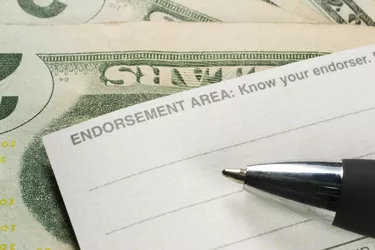
Your signature or endorsement on the back of a check authorizes the bank to give you the amount of money it's written for, either in cash or as a deposit to your bank account. Depositing it will require an additional step to create its own type of endorsement, but it's just a matter of a few words. The bank will credit your account balance by the amount of the check, assuming that the check writer has sufficient funds in their account to cover it and the check is honored.
How to Endorse a Check for Deposit Only
Video of the Day
- Specify the account and add the correct phrase. Your first step is to make it clear that you want the proceeds from the check to go to your checking account or savings account. Write "For deposit only to Account #123456789" at the top of the endorsement area on the back of the check. You don't have to write your account number if you don't want to, particularly if your checkbook provides blank deposit slips that bear your account number. You can submit one of them with the check to be deposited. Many banks and credit unions require that you add an extra word if you're using a mobile banking app. The Educational Employees Credit Union requires that you write "For mobile deposit only." Online banking doesn't usually require a similar notation.
- Endorse the check. Next, endorse the check by signing your name below the for-deposit-only notation. Always make sure that your name is spelled correctly on the front of the check. This rule applies whether you want to deposit checks or cash checks. The name entered on the payee line of the check governs the process of endorsing it. Huntington National Bank indicates that you should first sign your name the way it appears on the front of the check, right beneath your "deposit only" directive, then sign your name again with its correct spelling right beneath this.
Video of the Day
Why Would You Write “For Deposit Only” on a Check?
The Consumer Financial Protection Bureau advises that a check can't be presented to a financial institution in exchange for cash after you've written "for deposit only" in the endorsement area. You might enter these words as a safeguard in case the check is lost, stolen or misplaced after you've endorsed it but you haven't yet taken it to the bank or made an online or mobile deposit.
Secure and Restricted Endorsement Explained
"For deposit only" is referred to as a "restricted endorsement" because of the protection these three words provide. It's a "blank endorsement" if you don't add them, simply signing your name to the back of the check as the endorsement instead, according to the Credit Union National Association. Anyone can technically present the check for payment if that's all you've done. An endorsed check with no other directive is effectively the same as cash.
Writing "for deposit only" plus your checking account number restricts the check from being deposited to any bank account other than the one you've cited.
Frequently Asked Check Questions
Some FAQs about signing and depositing checks include:
What Is the Endorsement Area of a Check?
Some checks provide a line or series of lines on the back. They should appear at the left side when you turn the check over, not at the top where the issuer's name, address and check number appear on the front side.
You might also see a printed warning not to write or sign anything beneath the bottom line, according to MyCreditUnion.gov.
The EECU indicates that some checks also provide a box here that you can check if you want to make a mobile deposit, but you should also write "for mobile deposit only" as well.
What Is the Safest Way to Deposit a Check?
The EECU warns that you should take the precaution of waiting to sign your name to the check until you're at the bank or ready to make your mobile deposit. The restrictive endorsement of "for deposit only" notation will prevent it from being exchanged for cash, but you still want to be sure that the money goes into your bank account, not someone else's.
Check fraud is an ongoing problem, and nothing prevents a thief from crossing out your bank account number if you've included one and entering their own, although this would almost certainly raise a bank teller's eyebrows and create questions.
- Consumer Financial Protection Bureau: What Does It Mean for a Check To Be Endorsed ‘For Deposit Only’?
- Huntington National Bank: How To Endorse a Check: What It Means To Endorse a Check
- MyCreditUnion.gov: Understanding a Check
- Educational Employees Credit Union: How to Endorse a Check for Mobile Deposit – New Rules
- Credit Union National Association: Check Endorsement Training Guide
- Educational Employees Credit Union: Protect Yourself From Fraud When Endorsing a Check